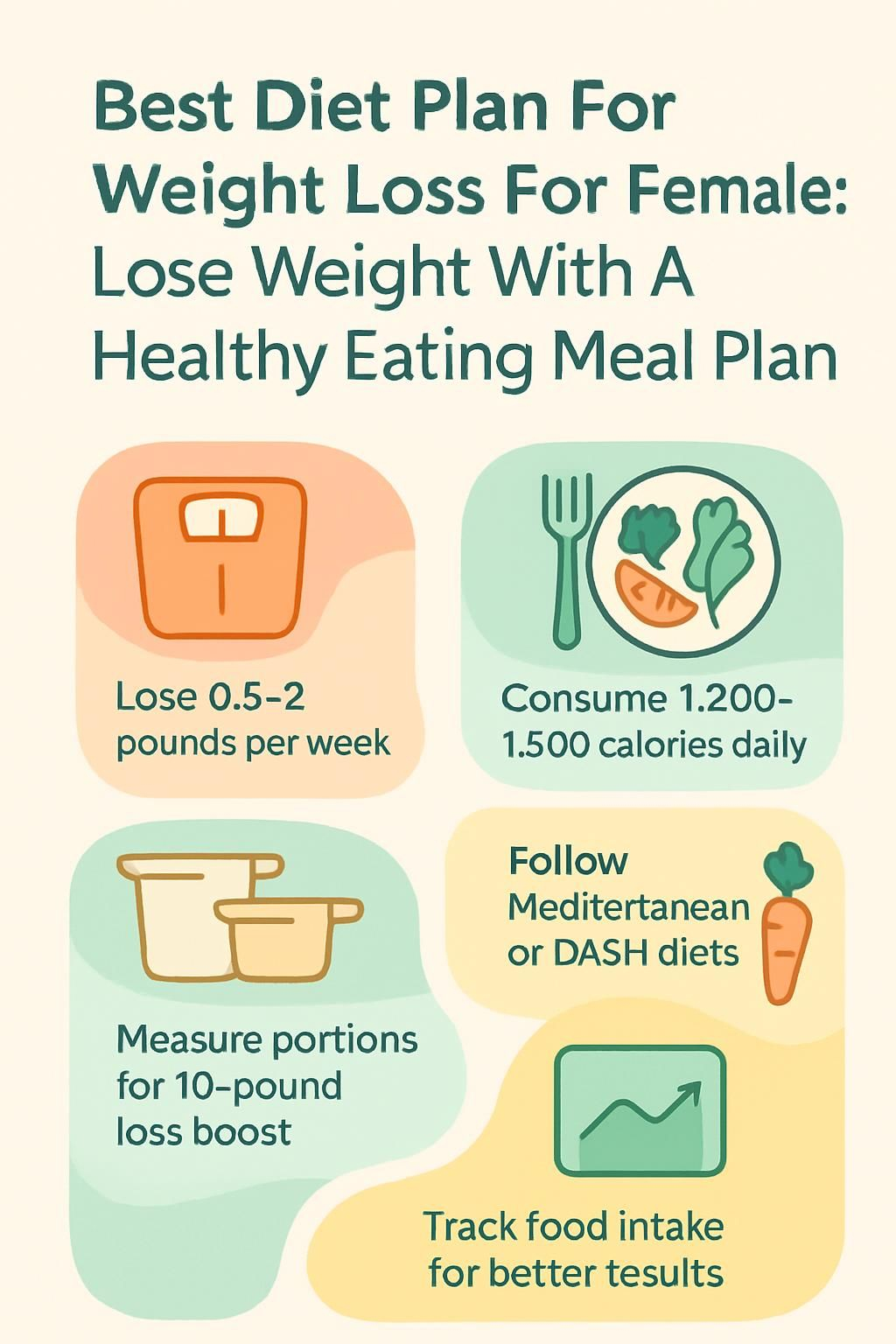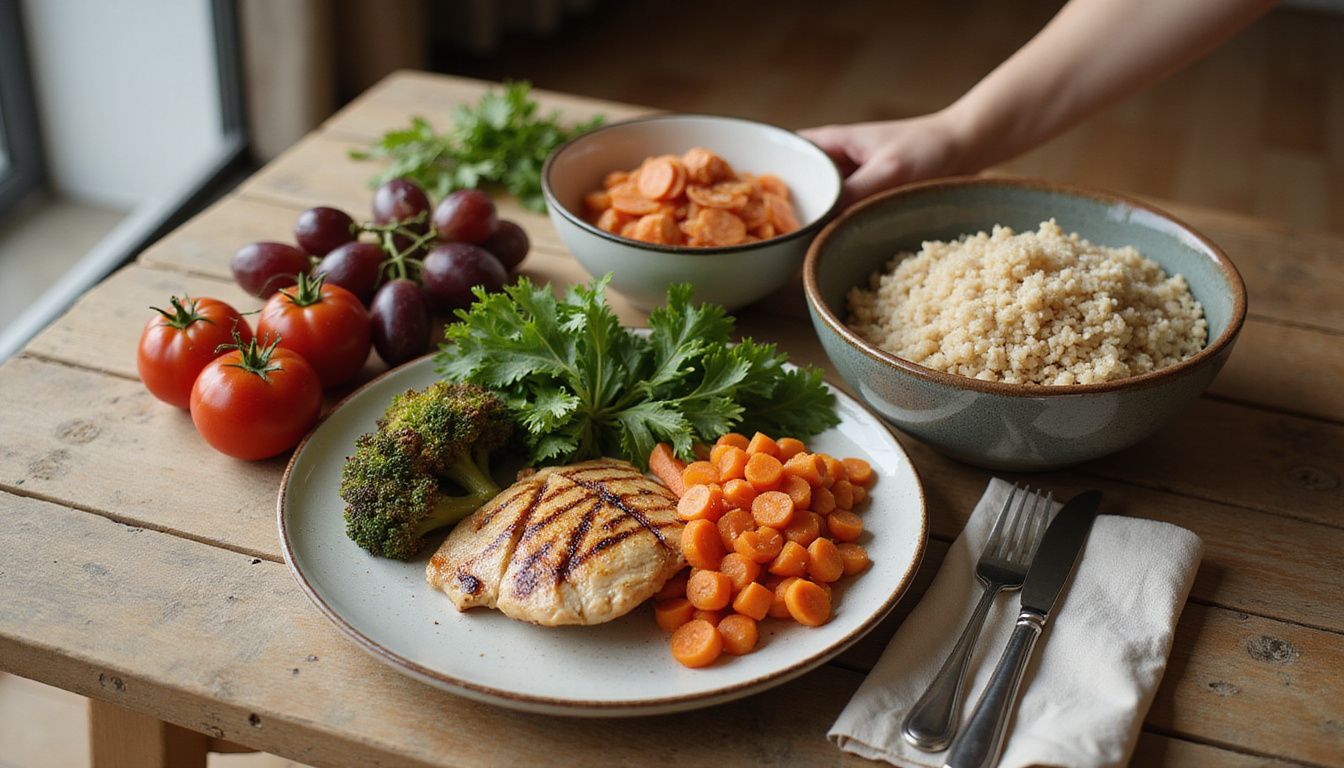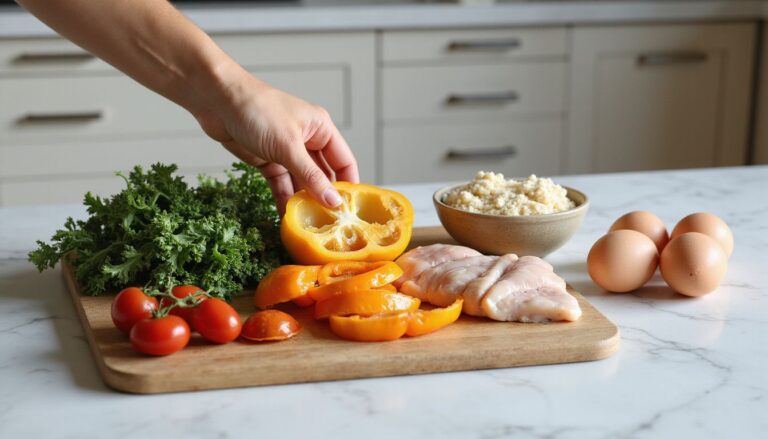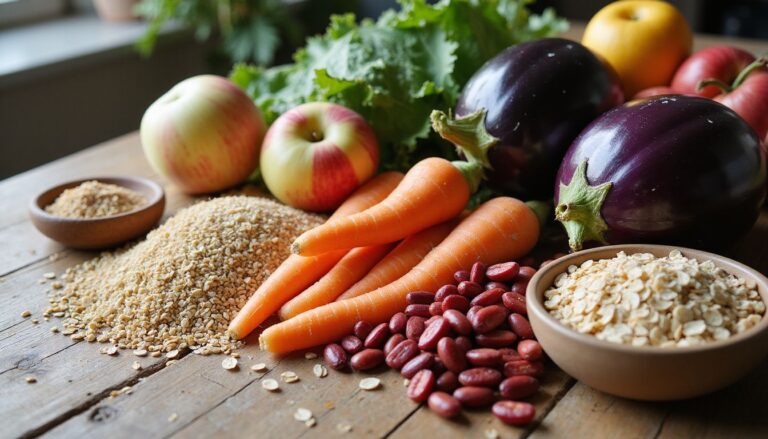Best Diet Plan For Weight Loss For Female: Lose Weight With A Healthy Eating Meal Plan
Our Nutrition Assistant AI Suite will transform your body. You will lose fat, get toned, and build muscle. Gain confidence and optimal health.
Struggling to find a diet plan that helps you lose weight and actually fits your life? A clear, balanced meal plan can help you drop 1 to 2 pounds per week while supporting your health. This guide breaks down healthy eating into simple steps, so you can build habits that last.
You will get practical advice, science-backed tips, and sample meals you can use right away. Start small, stay steady, and let your routine do the heavy lifting, your new path starts here.
Key Takeaways
- Aim to lose 0.5 to 2 pounds per week. A first target of 5% to 10% of starting weight is realistic and protective for health.
- Meal patterns like Mediterranean and DASH are supported by major studies and lower the risk of heart disease and diabetes.
- Portion control matters. Measuring servings can lead to about 10 pounds more loss over six months.
- Most women do well at 1,200 to 1,500 calories per day for weight loss, focusing on lean protein, whole grains, produce, and healthy fats.
- Food logs and apps improve calorie awareness. Slow, steady changes build habits you can keep.

What Are Effective Weight Loss Goals for Women?

Most experts suggest a safe pace of 0.5 to 2 pounds per week. Setting a goal to lose 5% to 10% of your starting weight can improve blood pressure and blood sugar, and it can ease heart disease risk.
Focus on balanced meals, portion sizes, and daily movement as you plan your targets. Tracking with a food journal or app keeps daily calories in range. Avoid very low-calorie plans unless a clinician guides you. I used a Mayo Clinic Diet style template for structure, and the steady progress felt doable week after week.
“Small changes every day add up to big results over time.”
Next, learn the core principles that shape a healthy eating plan for lasting weight control.
Key Principles of a Healthy Diet Plan
Healthy weight loss starts with a few simple rules. These principles help you make smart choices in any setting, from home kitchens to busy workdays.
What Is Balanced Nutrient Intake?
Balanced intake means your meals include all the key food groups. Build each plate with smart carbs, lean protein, and healthy fats, plus plenty of fruits and vegetables for vitamins, minerals, and dietary fiber. Choose whole grains like oats or brown rice for steady energy. Pick low-fat or nonfat dairy to limit saturated fat.
Simple swaps help. Choose fish for omega-3s, beans or tofu for plant protein, and nuts or olive oil for healthy fat. I often plan around a colorful salad topped with grilled chicken or chickpeas. It keeps me full and makes hitting nutrition goals easier.
| Food Group | Example Foods | Daily Target |
|---|---|---|
| Whole Grains | Brown rice, oatmeal | 3 to 5 servings |
| Lean Proteins | Fish, tofu, chicken | 2 to 4 palm-size portions |
| Fruits and Vegetables | Berries, spinach, mixed veggies | Fill at least half your plate |
| Dairy | Low-fat yogurt or milk | 2 to 3 servings |
| Healthy Fats | Olive oil, nuts, seeds | Use small amounts |
This structure keeps your plan simple yet flexible, so you can enjoy variety each week.
How Does Portion Control Aid Weight Loss?
Portion control prevents sneaky calorie creep. Smaller servings help you meet your calorie goal without cutting full food groups. Even healthy foods can slow progress if portions keep growing.
Tricks like smaller plates and pre-portioning snacks work well. Studies show that people who measure servings lose about 10 more pounds over six months. I stopped eating from large bags and portioned chips into small bowls. That one change curbed mindless eating and sped up my results.
Portion control is a quiet habit that adds up. You still eat the foods you like, just in amounts that fit your plan.
Why Is Calorie Management Important?
Calories are units of energy. If you eat more than you burn, your body stores the extra as fat. Over time, that raises the risk of obesity, heart disease, type 2 diabetes, and certain cancers.
Most women need around 1,200 to 1,500 calories per day to lose weight, depending on age, size, and activity. Using a tool like the free NHS weight loss plan or a tracking app helps you choose nutrient-dense foods over sugary drinks or desserts.
Calories are not just numbers; they are energy your cells use every minute.
Knowing your numbers makes portion choices easier. Next, see how a steady meal plan supports both weight and wellness.
Benefits of a Healthy Eating Meal Plan
A good plan is like a roadmap. It keeps you moving forward without guessing at every turn.
How Does It Support Sustainable Weight Loss?
Balanced meals built around whole grains, lean proteins, fruits, vegetables, and healthy fats improve fullness and cut excess calories. Losing 1 to 2 pounds per week is safe and more likely to last. Evidence-based plans also support blood pressure, cholesterol, and insulin control, which helps people with diabetes.
Planning meals in advance reduces last-minute choices and makes your new routine stick. Over time, it feels less like a diet and more like your normal way to eat.
What Are the Health Improvements?
Healthy meal patterns lower the risk of chronic disease, including heart disease, type 2 diabetes, breast cancer, and colorectal cancer. The DASH plan uses lower sodium to manage high blood pressure. Mediterranean-style eating, which focuses on plants and olive oil, may also support brain health as you age.
Balanced meals improve gut health and immune function. My family shifted to Mediterranean-style recipes, using olive oil instead of butter and more beans and tomatoes. We noticed steadier digestion and better skin within months.
Some research links nutrient-rich eating with a more stable mood. A strong food base often supports mental well-being.
How Does It Boost Energy Levels?
Whole grains, lean proteins like eggs or beans, and healthy fats from nuts help keep blood sugar steady. That prevents energy spikes and crashes. Fiber slows digestion, so you feel satisfied longer.
Pairing this approach with regular activity can also improve sleep and reduce stress. Many women report more focus after switching to a Mediterranean or plant-forward style that includes plenty of produce and moderate fish.
Best Diet Plans for Weight Loss for Women
You have several strong options. Pick the style that feels both healthy and realistic for your week.
What Is the Mediterranean Diet?
The Mediterranean diet reflects traditional eating in places like Greece and Italy. It emphasizes fruits, vegetables, whole grains, beans, nuts, and seeds. Olive oil is the main fat. Fish and seafood appear a few times per week, and red meat is limited. Dairy is eaten in modest amounts, often as yogurt or cheese.
Research links this pattern to lower heart disease risk and better cholesterol levels. Studies also suggest benefits for blood pressure, blood sugar, certain cancers, and even lower risk of heart attack. I planned more meals around produce and swapped packaged snacks for roasted chickpeas or a small handful of nuts. Over time, my energy stayed more steady.
Curious about another option? The DASH diet is a strong choice too.
Citations:
- Estruch R., et al. Primary prevention of cardiovascular disease with a Mediterranean diet. New England Journal of Medicine. 2013;368:1279-1290.
- Sofi F. Mediterranean Diet and Health Status: An Updated Meta-Analysis. BMJ. 2008;337:a1344.
How Does the DASH Diet Work?
DASH stands for Dietary Approaches to Stop Hypertension. It focuses on fruits, vegetables, whole grains, lean proteins, and low-fat dairy. It limits sodium, processed meats, and foods high in saturated fat. Many people aim for less than 2,300 milligrams of sodium per day.
Meals center on fiber and lean proteins, so you feel full while staying within your calorie goal. Research also suggests DASH may lower long-term risk of diabetes and cognitive decline compared with a typical Western diet.
What Are the Benefits of a Plant-Based Diet?
Plant-based eating, such as vegetarian or vegan patterns, can lower daily calories and reduce saturated fat. You get more fiber, vitamins, and minerals from fruits, vegetables, beans, nuts, seeds, and whole grains. That supports digestion and steadier blood sugar.
Plant-rich diets are linked to healthier weight and lower cholesterol. They may also support brain health. I swapped beans for fatty meats and used vinegar slaw instead of mayo-based coleslaw. Afternoon slumps faded, and my energy evened out.
1 Reference: Morris et al., 2015, MIND Diet Study
How Does Intermittent Fasting Help?
Intermittent fasting alternates between eating and fasting windows. Popular styles include 16:8, which means 16 hours of fasting and an 8-hour eating window. It can reduce calorie intake without strict food rules, and some studies show improved blood sugar control.
Balanced meals still matter. Use the eating window to cover protein, whole grains, produce, and healthy fats. Talk with a healthcare provider first if you have any medical conditions or special dietary needs.
Creating a Personalized Diet Plan
A personal plan fits your body, your routine, and your goals. Small steps stacked together create strong momentum.
How to Assess Your Daily Calorie Needs
Knowing your daily calories helps you plan meals that support steady loss.
- Use a trusted calculator, such as the free NHS weight loss tool, to estimate your basal metabolic rate, the calories your body needs at rest.
- Factor in activity level, from 1.2 for low movement up to 1.9 for very active days.
- Create a daily deficit of about 500 calories to lose around one pound per week.
- Track intake with apps or labels and compare to your target.
- Adjust if you feel run-down or hit a plateau. You may need more food or a training change.
- Avoid going below 1,200 calories unless a clinician supervises it.
- Recheck your numbers every few weeks as your weight or activity changes.
- Seek advice from a registered dietitian if you have medical concerns or are pregnant.
Logging meals helped me spot hidden sugars in drinks and snacks. Cutting those kept me closer to my goal without feeling deprived.
How to Choose the Right Macronutrient Balance
Macronutrients are carbs, protein, and fat. Getting the mix right supports energy, muscle, and fullness.
- Calculate daily calories using a trusted resource, such as NHS or CDC tools.
- Aim for 45% to 65% of calories from carbs, favoring whole grains, fruits, and vegetables over sweets.
- Set protein at 15% to 30%, using fish, poultry, eggs, tofu, beans, and low-fat dairy.
- Allocate 20% to 35% to healthy fats, like olive oil, avocado, nuts, and seeds.
- Adjust based on activity. Endurance days often need more carbs. Some people feel better with lower carbs.
- Flexitarian and plant-forward styles let you blend plant and animal proteins in a sustainable way.
- Track your hunger, energy, and progress, then fine-tune as needed.
- Consult a registered dietitian before major changes to avoid nutrient gaps.
- Use free planning guides, such as download the free NHS weight management resources, for easy templates.
This framework supports steady loss while protecting long-term health.
Why Incorporate a Variety of Food Groups?
Variety helps you cover all your nutrient needs and keeps meals interesting. Whole grains deliver energy. Lean proteins protect muscle and improve fullness. Healthy fats support heart and brain function. Fruits and vegetables supply fiber and protective antioxidants.
Rotating foods also reduces boredom and may prevent overeating. A colorful plate is a quick check that you are getting a good mix.
Sample 7-Day Healthy Eating Meal Plan
Here is a one-week example to show how a delicious, healthy week can look while you are trying to lose weight. Adjust portions to match your calorie target.
What to Eat on Day 1: Breakfast, Lunch, and Dinner
- Breakfast: Oatmeal with a drizzle of honey and sliced fruit for steady energy.
- Add a small handful of nuts or seeds for healthy fats that boost fullness.
- Choose water or herbal tea instead of juice to save calories.
- Lunch: Grilled chicken over mixed greens with tomatoes, cucumbers, and olive oil vinaigrette.
- Add a slice of whole grain bread or a small serving of brown rice for complex carbs.
- Snack: Plain Greek yogurt or carrot sticks to curb cravings.
- Dinner: Baked salmon or tofu with steamed broccoli and quinoa for protein and fiber.
- Use the plate method, half vegetables, one quarter protein, one quarter whole grains.
- Limit highly processed foods that add sodium and extra calories.
- If you feel bloated after meals, switch fizzy drinks for still water.
Simple, balanced meals help you stay on track without feeling deprived.
What to Eat on Day 2: Breakfast, Lunch, and Dinner
- Breakfast: Overnight oats with low-fat milk, chia seeds, blueberries, and cinnamon for fiber and steady blood sugar.
- Snack: A small apple or pear for vitamins and light calories.
- Lunch: Grilled chicken over spinach and arugula with cucumber, cherry tomatoes, and olive oil vinaigrette.
- Add quinoa or brown rice for lasting energy until dinner.
- Snack: Plain low-fat Greek yogurt with a teaspoon of honey for protein and probiotics.
- Dinner: Baked salmon with roasted sweet potatoes and steamed broccoli. Fish twice per week supports heart health.
- Hydrate with water or herbal tea and limit sugary drinks.
- Try a cup of chamomile tea in the evening to unwind.
Each choice supports calorie control and balanced nutrition.
What to Eat on Day 3: Breakfast, Lunch, and Dinner
- Breakfast: High-fiber oatmeal topped with fresh berries and ground flaxseed to stay full until lunch.
- Lunch: Leafy greens with grilled chicken, tomatoes, cucumbers, and chickpeas. Use an olive oil dressing for healthy fats.
- Snack: Carrot sticks or an apple to keep calories down while staying satisfied.
- Dinner: Grilled salmon or another lean protein with steamed broccoli and quinoa for a complete plate.
- Drink water throughout the day to support focus and curb snacking.
- Limit processed foods that add sodium and trans fats.
- Track your calories with a free tool or the free NHS app to stay on target.
Day 3 keeps things simple, balanced, and easy to follow.
What to Eat on Day 4: Breakfast, Lunch, and Dinner
- Breakfast: Whole grain oatmeal with banana slices and chia seeds for fiber and steady energy.
- Snack: Low-fat Greek yogurt with strawberries for protein and antioxidants.
- Lunch: Grilled chicken over a mixed green salad with tomatoes, cucumbers, and olive oil vinaigrette.
- Snack: Raw carrot sticks or apple slices for a crunchy, low-calorie bite.
- Dinner: Baked salmon with steamed broccoli and quinoa for omega-3s, vitamins, and whole grains.
- Beverage: Water or unsweetened tea to avoid added sugar.
- Dessert (optional): A small bowl of blueberries or a few squares of dark chocolate.
Repeat this structure whenever you need a reliable, low-effort day.
What to Eat on Day 5: Breakfast, Lunch, and Dinner
- Breakfast: Low-fat Greek yogurt with mixed berries. Add one tablespoon of chia seeds for extra fiber.
- Lunch: Grilled salmon with a quinoa salad, tomatoes, spinach, cucumbers, and olive oil.
- Snack: An apple with about ten almonds if you get hungry.
- Dinner: Brown rice with sautéed bell peppers, carrots, and broccoli. Add four ounces of lean chicken breast.
- Season with herbs and spices to keep sodium low.
- Drink at least eight cups of water to support appetite control.
- Avoid sugary snacks and drinks to stay within your calorie target.
These choices make it easier to hit your goals while enjoying your food.
What to Eat on Day 6: Breakfast, Lunch, and Dinner
- Breakfast: Plain Greek yogurt with blueberries and one tablespoon of chia seeds for protein and fiber.
- Snack: A small apple or about ten almonds if needed.
- Lunch: Whole grain wrap with grilled chicken, spinach, tomatoes, cucumbers, and one tablespoon of hummus.
- Snack: Carrot sticks with hummus or a boiled egg to prevent cravings.
- Dinner: Grilled salmon over quinoa with steamed broccoli. Aim for about three ounces of salmon and half a cup each of quinoa and broccoli.
- Dessert: Half a cup of fresh strawberries, if you want something sweet.
- Hydrate with water or unsweetened tea, about eight cups for the day.
Day 6 centers on portion control and nutrient-dense foods.
What to Eat on Day 7: Breakfast, Lunch, and Dinner
- Breakfast: Oatmeal with fresh berries and chopped walnuts. Add a glass of low-fat milk for extra protein and calcium.
- Snack: A small apple or orange to keep hunger in check.
- Lunch: Quinoa salad with cherry tomatoes, spinach, chickpeas, cucumbers, and lemon. Add grilled chicken or tofu.
- Snack: Greek yogurt with a sprinkle of chia seeds for a protein boost.
- Dinner: Grilled salmon or tilapia with steamed broccoli and roasted sweet potato for omega-3s and fiber.
- Hydration: Choose water or herbal tea over sugary drinks throughout the day.
- Dessert: Sliced strawberries with a light drizzle of honey, if desired.
Sticking to simple, whole foods makes your week feel lighter and more predictable.
Foods to Include in Your Diet Plan
Building a strong base of nutrient-dense foods makes healthy eating easier. Here are the staples that support your goals.
Why Choose Whole Grains?
Whole grains like brown rice, oats, quinoa, and whole wheat bread offer fiber, B vitamins, and minerals. They digest more slowly than refined grains, so you stay full longer. That helps control calories and supports steady energy.
Research also links whole grains to lower risk of heart disease and type 2 diabetes. A small swap, like oatmeal for breakfast or brown rice instead of white, can make a noticeable difference over time.
What Are the Best Lean Proteins?
Lean proteins include skinless chicken breast, turkey, fish such as salmon or cod, eggs, low-fat dairy, tofu, tempeh, and beans. They deliver plenty of protein with less saturated fat than many processed or fatty meats.
Three ounces of cooked chicken breast has about 26 grams of protein and only a few grams of fat. Salmon supplies protein plus omega-3 fats. I swapped sausage for grilled fish at dinner and felt fuller without late-night snacking.
Which Healthy Fats Should You Eat?
Healthy fats come from nuts, seeds, avocado, olive oil, and fatty fish. They support heart and brain health. Replace butter with olive or canola oil in cooking.
Omega-3 fats may reduce inflammation and support brain function, according to the American Heart Association. A small handful of walnuts or a tablespoon of chia seeds fits easily into most plans.
[1] American Heart Association, Fish and Omega-3 Fatty Acids, updated Sept. 27, 2021
Why Eat Fresh Fruits and Vegetables?
Fruits and vegetables are low in calories and high in water and fiber. They help you feel full and deliver vitamins, minerals, and antioxidants that support your immune system and long-term health.
Getting at least five servings per day is linked to lower risk of type 2 diabetes. I keep cut-up carrots and apples ready in the fridge. Grabbing those makes it easier to skip high-sugar snacks.
Foods to Avoid or Limit
Some foods work against your goals. Limiting them can speed progress and support better health over time.
Why Limit Sugary Snacks and Drinks?
Sweet snacks and drinks add many calories with little nutrition. They cause quick spikes in blood sugar, followed by crashes that leave you hungry. Adults who eat more added sugar face higher risks of obesity, type 2 diabetes, and heart disease.
One can of regular soda has about 150 calories and almost no nutrients. Choose water or unsweetened tea, and save sugar for planned treats. If cravings hit, talk with your clinician about lower-sugar options that still feel satisfying.
What Are the Risks of Processed Foods?
Processed foods often pack added sugars, unhealthy fats, sodium, and additives. Eating them often raises the risk of obesity, type 2 diabetes, heart disease, and some cancers. Processed meats, in particular, are linked with higher cardiovascular risk.
These foods can also increase cravings and reduce energy because they lack fiber and key nutrients. Choosing fresh or minimally processed options helps you stay full and stick to your plan.
How Does Excessive Sodium and Trans Fats Affect You?
Too much sodium raises blood pressure, which strains your heart and arteries. Most adults should aim for less than 2,300 milligrams per day. Fast foods, canned soups, and salty snacks add up fast.
Trans fats raise LDL, the bad cholesterol, and lower HDL, the good kind. Even small amounts can raise heart disease risk. I felt better after cutting packaged chips and making simple homemade snacks.
Reducing sodium and trans fats protects your heart while you work toward a healthy weight.
Importance of Physical Activity in Weight Loss
Food sets the foundation. Movement turns that foundation into steady results.
What Types of Exercises Complement a Diet?
- Brisk walking is gentle on joints and burns about 150 calories in 30 minutes.
- Strength training 2 to 3 days per week builds lean muscle, which raises resting calorie burn.
- Running at a moderate pace can burn up to 300 calories in 30 minutes.
- Cycling is low impact and targets major leg muscles.
- Swimming works your whole body and burns about 200 calories in half an hour.
- Group classes like Zumba or spin can boost motivation and accountability.
- Yoga builds flexibility and reduces stress that can drive emotional eating.
Mixing cardio and strength gives you the best blend of calorie burn and muscle support.
What Are the Benefits of Regular Movement?
Frequent movement improves how your body uses calories. It helps manage blood sugar and blood pressure, and lowers risk for heart disease and type 2 diabetes. Daily activity also lifts mood and supports better sleep.
Short walks, taking the stairs, or stretch breaks add up. Women who weave activity into their day often see better long-term results.
Tips to Stay Consistent with Your Diet
Consistency beats perfection. Simple systems keep you on track during busy weeks.
How Can Meal Prepping and Planning Help?
Planning removes guesswork and helps you control portions and calories. People who plan meals are more likely to eat a healthy diet and maintain a normal weight. Prepping once or twice a week saves time, reduces stress, and makes it easier to skip takeout.
Use a short checklist, protein, whole grain, two vegetables, healthy fat. Repeat with different flavors to keep variety.
How to Set Realistic Weight Loss Goals
Set goals that match your life and current habits. Aim for one to two pounds per week. Break big targets into small milestones you can track, such as five pounds in a month or a clothing size by a certain date.
Use apps or journals to log progress. Small wins add up and help you adjust with less stress.
Why Track Your Progress?
Tracking builds awareness and motivation. People who monitor food and activity often lose nearly twice as much weight as those who do not. Record calories, steps, workouts, and how you feel.
Patterns will appear. You will see what meals keep you full and which habits trip you up. Photos and measurements can show changes even if the scale moves slowly.
Common Challenges and How to Overcome Them
Hitting bumps is normal. Smart tactics help you move past them and stay engaged.
How to Manage Cravings Effectively
- Spot your triggers, such as stress or boredom, and note timing in a journal.
- Build meals with whole grains, lean protein, healthy fats, fruits, and vegetables to stay full.
- Drink water first, thirst can feel like hunger.
- Keep nuts, yogurt, or sliced veggies ready for quick snacks.
- Use a short distraction, a brief walk or a text to a friend, when a craving hits.
- Include planned treats in small portions to prevent binges.
- Practice mindful eating, slow down and notice flavors and textures.
- Get 7 to 9 hours of sleep, poor rest increases hunger hormones.
- Manage stress with yoga, breathing exercises, or simple stretching.
- Track your choices to see what works best for you.
These steps helped me stick to my plan without feeling restricted.
How to Break Through Weight Loss Plateaus
- Track everything for a week to spot hidden calories and portion creep.
- Add more movement, such as extra walks or short bursts of activity.
- Change your routine with new exercises or interval training.
- Recalculate your calorie needs after weight loss, smaller bodies need fewer calories.
- Increase protein at each meal to protect muscle and boost fullness.
- Prioritize 7 hours of quality sleep to reduce cravings.
- Hydrate well, mild dehydration can feel like hunger.
- Reduce stress with simple daily practices to keep cortisol in check.
Small tweaks often restart progress within a week or two.
FAQs About Weight Loss and Diet Plans
These answers cover common questions so you can move forward with confidence.
What Is the Best Diet Plan for Quick Weight Loss?
Lower-calorie approaches like Mediterranean or reduced-carb meal plans can deliver early results and improve health markers. Some trials show women can lose several pounds in four weeks while improving heart health.
Focus on whole grains, lean protein, produce, and portion control. Intermittent fasting can help some people by shrinking the eating window. Track your calories and keep activity consistent for the best effect.
How Many Calories Should Women Consume to Lose Weight?
Most women lose weight at 1,200 to 1,500 calories per day, though needs vary by size and activity. Creating a daily deficit of about 500 calories often leads to one pound of weekly loss.
Apps can reveal how quickly snacks add up. Careful logging helped me stay on target without constant hunger. A clinician or dietitian can tailor your plan to your health history and goals.
Can I Indulge Occasionally and Still Lose Weight?
Yes. Planned treats in small portions can fit into a healthy plan. This approach reduces cravings and makes your plan easier to follow long term. Keep most meals nutrient-dense, and you can enjoy a dessert now and then.
I include dark chocolate some weeks and still make steady progress. Balance and portion size are the keys.
Conclusion
A clear meal plan helps you lose weight, feel energized, and support your long-term health. Set realistic goals, build balanced plates, and keep portions in check. Evidence-based patterns like Mediterranean and DASH make healthy eating easier to sustain.
Pair your diet plan with regular physical activity for stronger results. Stay consistent, track what matters, and adjust as you learn. For medical concerns or special needs, speak with a healthcare professional or registered dietitian before major changes.
Healthy eating is a skill you practice. Keep it simple, stay steady, and progress will follow.
Medical disclaimer: This content is educational and is not a substitute for personalized medical advice. Consult your healthcare provider for guidance specific to you.
FAQs
1. What is the best diet plan for weight loss for women?
A balanced eating plan that includes lean protein, whole grains, fruits, and vegetables supports healthy weight loss in women. Studies show that reducing added sugars and processed foods helps lower body fat while maintaining muscle mass.
2. How many calories should a woman eat daily to lose weight?
Most adult females need about 1,200 to 1,500 calories per day for safe weight reduction according to clinical guidelines. The exact number depends on age, activity level, height, and starting weight.
3. Can meal planning help with losing weight?
Meal planning encourages portion control and reduces impulsive food choices; research shows it leads to more consistent calorie intake and better nutrition quality over time.
4. Are there specific nutrients important in a female’s diet plan for losing pounds?
Protein helps preserve muscle during calorie restriction; fiber from vegetables and grains increases fullness; iron supports energy levels which are often low when dieting according to nutritional studies.
Summary: A structured meal plan focused on nutrient-rich foods aids steady fat loss in women without sacrificing health or energy levels. Tracking portions and choosing high-protein meals can make the process easier based on evidence from dietary research as well as personal experience with planned weekly menus leading to sustainable results.







